Introduction
I know some of you won't believe me, but a long time ago, when the internet was young, there was no such thing as Google. Honestly, I'm not making that up. By the time I started this site in 1999, most of the current search engines had already been around for a couple of years, Excite, Google, Lycos, MSN, WebCrawler, Yahoo and the rest but they were slow and hadn't indexed that many sites. Not that there many around, around 2 million as compared to today's 1 billion (January 2014). In January 2023, there are around 2 billion.
In order to help increase the visitors to a web site there were a couple of strategies that people employed, banner links; reciprocal link exchange pages, web "awards" and webrings.



What Webrings Are
Webrings were, and still are, a system that grouped and linked web sites of similar content together. A webring manager would create a piece of code either using their own independent system or one from the organizations such as RingSurf, Bravenet's Site Ring, WebRing, WebRingo, RingLink (later World of Webrings (WOW) and now Web Ring World), Alt-Webring, RingsWorld, Looplink, OneSeek's WebChains or one of the others.
People would ask to join a webring and they would, if accepted, be given a unique identifier, the images, and the code to be placed on one of their pages. There were a variety of methods used to display the images and links. Bravenet's Sitering used an image map, Ringsurf used tables and Webring used either a JavaScript snippet or a table at different times. Some ring managers would insist that the webring code be placed on the homepage, others would allow them to be placed on a "web ring" or links page.
The code would usually provide links to the ring home, links to the next and previous in the ring and be able to provide a list of sites in the webring. Some would even pick a random page to visit.
At one time I belonged to over 30 webrings! The Webring JavaScript snippet was interesting. A couple of lines of code would pull all the rings you belonged to in that and display them all. As it was the largest system, I belonged to 25 of those.
<!-- Start of Code for the Webring System -->
<center>
<script type="text/javascript" src="http://ss.webring.com/navbar?f=j;y=brisray;u=10026751"></script>
Navigation by <a href="http://dir.webring.com/rw" target="_top">WebRing</a>.
</center>
<!-- End of Code for the Webring System -->
That piece of code would end up on the page looking like this:
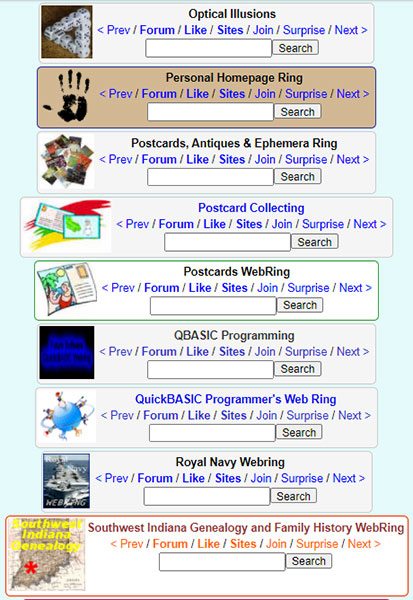
The following code shows the Bravenet Sitering code to produce the imagemap for the International Maritime Ring, and the table layout for Webring's History web ring and the RingSurf European History web ring. The snippets would run code on their servers to produce the links using the ring and your personal ID.
<table width="100%" border="0">
<tr>
<td valign="top" width="50%">
<!--- Begin Bravenet.com Sitering Panel Code --->
<div >
<div align="center">
<span class="story">
<map name="imrmapMap">
<area shape="rect" coords="20,70,228,90" href="http://pub7.bravenet.com/sitering/nav.php?usernum=541797513&action=join&siteid=74295" target="win2" alt="Join">
<area shape="rect" coords="5,98,63,108" href="http://pub7.bravenet.com/sitering/nav.php?usernum=541797513&action=prev&siteid=74295" target="win2" alt="Previous Site" title="Previous Site">
<area shape="rect" coords="68,98,110,108" href="http://pub7.bravenet.com/sitering/nav.php?usernum=541797513&action=list&siteid=74295" target="win2" alt="List Sites" title="List Sites">
<area shape="rect" coords="114,98,134,108" href="http://www.donpedroshipping.co.uk/International-Maritime-Ring/" target="win2" alt="Join the Ring" title="Join the Ring">
<area shape="rect" coords="140,97,198,110" href="http://pub7.bravenet.com/sitering/nav.php?usernum=541797513&action=random&siteid=74295" target="win2" alt="Random Site" title="Random Site">
<area shape="rect" coords="205,96,246,109" href="http://pub7.bravenet.com/sitering/nav.php?usernum=541797513&action=next&siteid=74295" target="win2" alt="Next Site" title="Next Site">
</map>
<img src="imrmap.jpg" width="250" height="114" usemap="#imrmapMap" border="0" alt="International Maritime Ring"></span><br>
</div>
</div>
<!--- End Bravenet.com Sitering Panel Code --->
<br>
<!-- Beginning of code for History webring-->
<div><center>
<table border="10" cellpadding="3" cellspacing="3" width="500">
<tr>
<th><a href="http://members.tripod.com/~PHILKON/ring.html"><img src="history.gif" align="left" hspace="0" width="125" height="80"></a> <a href="http://www.webring.org/cgi-bin/webring?ring=history&id=1098&next"><img src="historynext.gif" align="right" hspace="0" width="125" height="80"></a> This "The History Ring" site is owned by<br>
<a href="mailto:mailto:brisray@yahoo.co.uk">Ray Thomas</a>.<br><br>
Want to join <a href="http://members.tripod.com/~PHILKON/ring.html">The History Ring</a>? </th></tr><tr>
<th>[<a href="http://www.webring.org/cgi-bin/webring?ring=history&id=1098&sprev" target="_top">Skip Prev</a>]
[<a href="http://www.webring.org/cgi-bin/webring?ring=history&id=1098&prev" target="_top">Prev</a>]
[<a href="http://www.webring.org/cgi-bin/webring?ring=history&id=1098&next"
target="_top">Next</a>]
[<a href="http://www.webring.org/cgi-bin/webring?ring=history&id=1098&skip"
target="_top">Skip Next</a>]
[<a href="http://www.webring.org/cgi-bin/webring?random&ring=history"
target="_top">Random</a>]
[<a href="http://www.webring.org/cgi-bin/webring?ring=history&id=1098&next5"
target="_top">Next 5</a>]
[<a href="http://www.webring.org/cgi-bin/webring?ring=history&list"
target="_top">List Sites</a>] </th>
</tr>
</table>
</center></div>
<!-- End of code for History webring-->
<br>
<!--Beginning of European History webring code-->
<div>
<table border="4" cellpadding="2">
<tr>
<td align="center"><p><a href="http://www.ringsurf.com/netring?ring=eurohist;action=home"
target="_top"><img src="eurologo5.gif" alt="European History Web Collection Logo 5" align="middle" border="0" width="144" height="124"></a></p>
</td>
<td align="center"><p>This <a href="http://www.ringsurf.com/netring?ring=eurohist;action=home"
target="_top">European History</a> Site<br>
is owned by <a href="mailto:brisray@yahoo.co.uk">Ray Thomas</a> </p>
<p>If you would like to join this ring<br>
<a href="http://www.ringsurf.com/netring?ring=eurohist;action=home"
target="_top">Click Here</a></p>
</td>
</tr>
<tr>
<td align="center" colspan="2"><p class="ctr"><b>[</b>
<a href="http://www.ringsurf.com/netring?ring=eurohist;id=51;action=prev5"
target="_top"><b>Prev 5</b></a><b>] [</b>
<a href="http://www.ringsurf.com/netring?ring=eurohist;id=51;action=prev"
target="_top"><b>Prev</b></a><b>] [</b>
<a href="http://www.ringsurf.com/netring?ring=eurohist;id=51;action=next"
target="_top"><b>Next</b></a><b>] [</b>
<a href="http://www.ringsurf.com/netring?ring=eurohist;id=51;action=rand"
target="_top"><b>Random</b></a><b>] [</b>
<a href="http://www.ringsurf.com/netring?ring=eurohist;id=51;action=next5"
target="_top"><b>Next 5</b></a><b>] [</b>
<a href="http://www.ringsurf.com/netring?ring=eurohist;action=list"
target="_top"><b>List</b></a><b>]</b></p>
</td>
</tr>
</table>
</div>
<!--End of European History webring code-->
</td>
</tr>
</table>The code isn't very pretty, but it worked and produced this on the page:
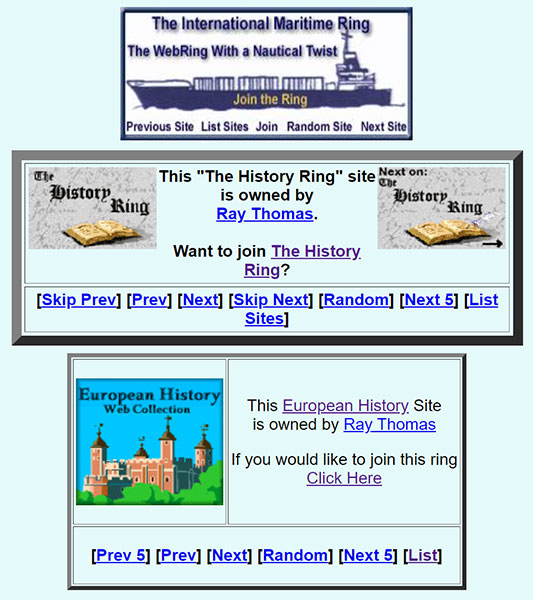
A Short History of Webrings
Denis Howe started EUROPa (Expanding Unidirectional Ring Of Pages) at Imperial College in 1994. The idea developed further when Giraldo Hierro conceptualized a central CGI (Common Gateway Interface) script to enhance functionality. Sage Weil developed such a script in May 1994. Weil's script gained popularity, pushing Weil in June 1995 to form a company called WebRing. In 1997, Weil sold WebRing to Starseed, Inc.
David P. Farrell is a co-founder of Starseed, Inc. and said in Hacker News that they bought WebRing from Sage Weil at a time when he was ready pursue other interests. He continues:
WebRing was awesome for its time - I personally did a lot to speed up the system that we purchased from Sage to help it keep scaling to the point where we could get acquired. Tim Killeen, eventual owner of WebRing after Yahoo left it to die, did some great additions to the technology to help keep it relevant for several more years.
I was onsite at GeoCities working to integrate WebRing into their system. Literally, on my final day onsite and the when were to demo the integration, the company all-hands announcing the sale to Yahoo happened. Exciting times !
In 1998 Starseed was acquired by GeoCities, who made no major changes to the system. Just a few months later, in early 1999, Yahoo! bought GeoCities, and eighteen months after the acquisition, on September 5, 2000, Yahoo! unveiled a fully overhauled WebRing, known as Yahoo! WebRing.

Although Yahoo!'s implementation was meant to streamline the way the rings were managed and provide a more consistent interface for all rings, many of these changes were unpopular with ringmasters accustomed to the older system which gave them more flexibility.
People really were upset by the takeover. Webrings started appearing called "Another Victim of Y! Hooliganism Screams", "The Day the Rings Died", "Because Webring is Broken", "The Y-Free Webring", "The Anti-Yahoo! Webring", and "The Pissed Off with Y!WebRing Web Ring".
On April 15, 2001, Yahoo! pulled their support of WebRing, leaving it in the hands of one technician from the original WebRing, Timothy Killeen. He unveiled a WebRing free of Yahoo! influence on October 12, 2001.

In the years since this change, many of the features which had been stripped by Yahoo!, particularly customization options, were reimplemented into the WebRing system. On September 26, 2006, Webring Inc. announced a new WebRing Premium Membership Program. They have separated memberships into two types, WebRing 1.0 and WebRing 2.0. Sites that are part of WebRing 1.0 will be limited to 50 webrings per URL. Existing 1.0 members can maintain more than 50, but can not add more.
In conjunction with the premium membership program, WebRing introduced an affiliate program, in which webmasters earn money when others join webrings from their site; they earn an additional payment if the new member purchases a premium membership.
In early October 2007, Webring was granted a trademark on "Webring" from the USA Trademark office. Also in that month, Yahoo's long partnership ended as Webring ownership repurchased Webring stock held by Yahoo, marking the first time since the late 1990s that Webring was again privately held.
By the beginning of 1997, there were over 1,000 webrings. By May of 1997 over 10,000. By April, 1998, there were over 40,000. By January 2000 there were over 80,000 which were used by around 1.5 million sites. The end came on August 15, 2020, when webring.com became inaccessible.
Two interesting articles about Sage Weil and WebRing are This Guy Just Sold His 2-Year-Old Startup For $175 Million In Cash (Internet Archive) and They’re Internet History (Internet Archive).
 It appears webring was international. While researching this page I came across WebRing Japan (Internet Archive). At least it was using the official Webring logo. This site lasted from 1998 until April 2007 when it was closed down. In July 2008 WebRing Japan (current site) reappeared again with a new logo and new owners. It appears to be still working April 2023.
It appears webring was international. While researching this page I came across WebRing Japan (Internet Archive). At least it was using the official Webring logo. This site lasted from 1998 until April 2007 when it was closed down. In July 2008 WebRing Japan (current site) reappeared again with a new logo and new owners. It appears to be still working April 2023.
I also found German (de), Italian (it) and Spanish (es) old webring sites, but these seem completely separate to the original WebRing system.
Much of the information for this section came from Wikipedia. Katharine Mieszkowski, a senior writer for Salon wrote a good history of WebRing and Yahoo! in the article The Strange Saga of Yahoo and WebRing on that site in 2001. Other marvelous sites about the history of webrings are James S. Huggins' Refrigerator Door (Internet Archive), and the History of Webrings page on Web Ring World. In late 1998, Joachim Verhagen created the Science Humor Netring using WebRing, that was soon ought by Yahoo! and by September 2000, he had left WebRing and recreated the site on RingSurf. Joachim wrote a couple of pages about his experience with the Science Humor Netring and the various companies hosting it at History of the Science Humor Webring.
A List of Webring Systems
WebRing was the largest of the original webring systems but there were others. The following is based on what I can find in the Internet Archive.
 Alt-Webring (Internet Archive) was owned by Andrew McPhee who started it in April 2003 due to his dissatisfaction with the other webrings. It used the Ringlink Perl program by Gunnar Hjalmarsson. In 2014, it was still going but the webring directory was broken. The site closed in February 2015.
Alt-Webring (Internet Archive) was owned by Andrew McPhee who started it in April 2003 due to his dissatisfaction with the other webrings. It used the Ringlink Perl program by Gunnar Hjalmarsson. In 2014, it was still going but the webring directory was broken. The site closed in February 2015.
 Bomis was formed in 1996 by Jimmy Wales, Tim Shell and Michael Davis and hosted hundreds of webrings. Hosting soft porn it also saw the start of Wikipedia and hosted it from January 15, 2001 to June 2003. The last time the Bomis site (Internet Archive) had any content was in 2010. In October 2014, it just said "Hello, World! and was gone by 2015."
Bomis was formed in 1996 by Jimmy Wales, Tim Shell and Michael Davis and hosted hundreds of webrings. Hosting soft porn it also saw the start of Wikipedia and hosted it from January 15, 2001 to June 2003. The last time the Bomis site (Internet Archive) had any content was in 2010. In October 2014, it just said "Hello, World! and was gone by 2015."
 Bravenet Site Ring (Internet Archive) was started in 2003 and in 2006/2007 became Bravenet Web Ring (Internet Archive). In 2014, the name reverted back to Site Ring (Internet Archive), then was discontinued in the summer of 2016.
Bravenet Site Ring (Internet Archive) was started in 2003 and in 2006/2007 became Bravenet Web Ring (Internet Archive). In 2014, the name reverted back to Site Ring (Internet Archive), then was discontinued in the summer of 2016.
 CrickRock (Internet Archive) was powered by the RingLink Perl program. The domain ws still active but giving a SQL error when I checked it on October 28, 2014. CrickRock appeared in December 2000 and lasted until late 2008.
CrickRock (Internet Archive) was powered by the RingLink Perl program. The domain ws still active but giving a SQL error when I checked it on October 28, 2014. CrickRock appeared in December 2000 and lasted until late 2008.
 FS Rings was a short-lived system that ran from 2003 to 2004. It was written in PHP with MySQL database.
FS Rings was a short-lived system that ran from 2003 to 2004. It was written in PHP with MySQL database.
 ICQ Webrings - not much has been preserved by the Internet Archive about these but they were active between 2001 and 2016.
ICQ Webrings - not much has been preserved by the Internet Archive about these but they were active between 2001 and 2016.
 Looplink (Internet Archive) appeared in January 1998 then disappeared in November 2000.
Looplink (Internet Archive) appeared in January 1998 then disappeared in November 2000.
 MIMAnet Webring Zone (Internet Archive) appeared in November 2000 and last appeared in May 2010. James Huggins (Internet Archive) wrote that the site had "apparently acquired the assets of the the Plebius.org site, including Martin Kretzman's perl script to operate a webring." Plebius (archive) seems to have been a web directory, programming source and generally as mixed bag of material. It first appeared in the Internet Archive in January 1999. It went through several changes, becoming Plebius Press, "a psychology resource center" in January 2003. "Publishing Solutions" in September 2005. A "Myspace Resource" in April 2006. "Politi Comments" in December 2012, and Pimp-my-Page, a social media resource in September 2013 and in 2020 is still being used for that.
MIMAnet Webring Zone (Internet Archive) appeared in November 2000 and last appeared in May 2010. James Huggins (Internet Archive) wrote that the site had "apparently acquired the assets of the the Plebius.org site, including Martin Kretzman's perl script to operate a webring." Plebius (archive) seems to have been a web directory, programming source and generally as mixed bag of material. It first appeared in the Internet Archive in January 1999. It went through several changes, becoming Plebius Press, "a psychology resource center" in January 2003. "Publishing Solutions" in September 2005. A "Myspace Resource" in April 2006. "Politi Comments" in December 2012, and Pimp-my-Page, a social media resource in September 2013 and in 2020 is still being used for that.
 OneSeek (Internet Archive) had a system called WebChains and appeared in July 1998. The WebChains seem to have stopped in April 2000, and the web site more or less closed down apart from their logo in September 2011. The site is still going but is now "a multi/meta search engine and web directory offering advanced web-enabled software" but doesn't look it has been updated since 2014.
OneSeek (Internet Archive) had a system called WebChains and appeared in July 1998. The WebChains seem to have stopped in April 2000, and the web site more or less closed down apart from their logo in September 2011. The site is still going but is now "a multi/meta search engine and web directory offering advanced web-enabled software" but doesn't look it has been updated since 2014.
 Orca Ringmaker is a self-hosted system written in PHP and using a MySQL database. It was written by Brian Huisman (GreyWyvern) in 2005 and was still being maintained in 2021. The page was still there in January 2023, but the code is no longer being maintained.
Orca Ringmaker is a self-hosted system written in PHP and using a MySQL database. It was written by Brian Huisman (GreyWyvern) in 2005 and was still being maintained in 2021. The page was still there in January 2023, but the code is no longer being maintained.
 Page-Ring (Internet Archive) appeared in February 2001 but was gone by November of the same year. It appears to have used Gunnar Hjalmarsson's RingLink Perl code base.
Page-Ring (Internet Archive) appeared in February 2001 but was gone by November of the same year. It appears to have used Gunnar Hjalmarsson's RingLink Perl code base.
![]()
 RingLink (Internet Archive) first appeared on February 22, 2001 and is still going as WOW Webring (World of Webrings)(Internet Archive). It seems that the owner, Gunnar Hjalmarsson, had his hosting company unexpectedly closed down in 2014 causing the change of URL. WOW was also a place to discuss the various webring systems while RingLink was the actual code base, a CGI Perl program. Ringlink v1 appeared in February 2001. The last was version was version 3.4 in January 2017. I revisited Web Ring World in December 2021, and it seems completely broken. Only 17 sites in 6 webrings are listed and those sites are all appear to be built on the same template and none of them have a link back into the other sites in the ring. The WOW Webring site disappeared in 2015, but Web Ring World is still available (February 2023) as a history of webrings.
RingLink (Internet Archive) first appeared on February 22, 2001 and is still going as WOW Webring (World of Webrings)(Internet Archive). It seems that the owner, Gunnar Hjalmarsson, had his hosting company unexpectedly closed down in 2014 causing the change of URL. WOW was also a place to discuss the various webring systems while RingLink was the actual code base, a CGI Perl program. Ringlink v1 appeared in February 2001. The last was version was version 3.4 in January 2017. I revisited Web Ring World in December 2021, and it seems completely broken. Only 17 sites in 6 webrings are listed and those sites are all appear to be built on the same template and none of them have a link back into the other sites in the ring. The WOW Webring site disappeared in 2015, but Web Ring World is still available (February 2023) as a history of webrings.
 Gunnar also seems to have hosted other webring systems on his site which used RingLink. One such was Web Ring System (Internet Archive) which ran from February 2003, to December 2004.
Gunnar also seems to have hosted other webring systems on his site which used RingLink. One such was Web Ring System (Internet Archive) which ran from February 2003, to December 2004.
 Lord of the Rings (LOR)(Internet Archive) also used RingLink and that was operating from September 2005 until October 2008.
Lord of the Rings (LOR)(Internet Archive) also used RingLink and that was operating from September 2005 until October 2008.
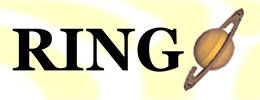 RINGo (Internet Archive) first appeared in 1999 and was administered by Kaloyan Tenchov. It started off with 18 webrings, had 32 in February 2001, 23 in March 2001, 19 in July 2001, 12 in March 2002, 15 in June 2002, 19 in December 2002 and that number had not changed right up to the site was last live in 2022. Most of the sites listed are gone, but some are still around.
RINGo (Internet Archive) first appeared in 1999 and was administered by Kaloyan Tenchov. It started off with 18 webrings, had 32 in February 2001, 23 in March 2001, 19 in July 2001, 12 in March 2002, 15 in June 2002, 19 in December 2002 and that number had not changed right up to the site was last live in 2022. Most of the sites listed are gone, but some are still around.
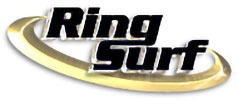 RingSurf appeared in 1997 and are still going but are ridiculously slow. I revisited RingSurf in December 2021, and every link was giving a server 504 timeout message. This was disappointing as RingSurf was the last remaining webring system I belonged to that was still running, even very slowly as it was.
RingSurf appeared in 1997 and are still going but are ridiculously slow. I revisited RingSurf in December 2021, and every link was giving a server 504 timeout message. This was disappointing as RingSurf was the last remaining webring system I belonged to that was still running, even very slowly as it was.

RingSurf 504 server timeout error, December 2021
The main RingSurf page was still up and running in January 2023, but every link is dead.
RingsWorld appeared in 2000, seems to have been relaunched in January 2006 then disappeared in May 2012.Oddly, it was archived in the Internet Archive but was removed some time after 2014 and now it just says "This URL has been excluded from the Wayback Machine."
 Stardust (Internet Archive) was a webring system that used RingLink. It appeared in January 2001 but had gone again by the end of 2003.
Stardust (Internet Archive) was a webring system that used RingLink. It appeared in January 2001 but had gone again by the end of 2003.
 The Rail (Internet Archive) along with Bomis is the oldest webring, both appearing in 1996. The Rail started on August 9, 1996, and lasted several years longer than Bomis, closing down in early 2017, after 20 years, 166 days and 15 hours!
The Rail (Internet Archive) along with Bomis is the oldest webring, both appearing in 1996. The Rail started on August 9, 1996, and lasted several years longer than Bomis, closing down in early 2017, after 20 years, 166 days and 15 hours!
Rather than use the metaphor of a ring as did everything that came after it, The Rail used a railway simile. Each ring was a train, and the train you were on would take you to a stop (a site in the ring). There were junction sites that connected two or more trains so you could continue on a different train than the one you started on.
The Rail was written C++ by Glacier Point Software and The Conductor, Enjay Sea, and hosted on a Unix server in Lincoln, Nebraska. It ran 66 trains (webrings) each containing hundreds of stops (sites). The Rail proved to be very popular with applications to join from 50 to 100 new sites submitted for connection to The Rail each day. About a third, around 20 to 40 of these sites were approved for membership.
The last message on The Rail (Internet Archive) says:
After 20 great years running The Rail, I regret that the time has come to close the site.
The web, and modern browsers have advanced to the point where a complete rewrite of The Rail has become necessary to keep up with all the changes. The Rail has always been a one man operation, and I'm afraid I just don't have the time with the various other projects I'm working on to accomplish that rewrite.
Consequently, this train must roll into the station. Thanks to all of The Rail members who shared my enthusiasm over the years, and good luck to you all.
Your Conductor, Enjay Sea
 WebRingo appeared in 2006 and I initially thought it was still going on March 2023, but I was wrong and I now class it as dead. As it was the only one left of the original type of webring managers in March 2023, I had a closer look at WebRingo and what I found was a little worrying. Since 2021, a group of people or maybe a single person, has been very busy on both WebRingo and Blogspot. Hundreds of new webrings have been created on the system, all with a single member site and all going to Blogspot pages. It is not like WebRingo has suddenly become popular among Blogspot members, because the pages the webring sites go to all look the same, with just a single page listing the dozens of webrings on WebRingo the same blog has created.
WebRingo appeared in 2006 and I initially thought it was still going on March 2023, but I was wrong and I now class it as dead. As it was the only one left of the original type of webring managers in March 2023, I had a closer look at WebRingo and what I found was a little worrying. Since 2021, a group of people or maybe a single person, has been very busy on both WebRingo and Blogspot. Hundreds of new webrings have been created on the system, all with a single member site and all going to Blogspot pages. It is not like WebRingo has suddenly become popular among Blogspot members, because the pages the webring sites go to all look the same, with just a single page listing the dozens of webrings on WebRingo the same blog has created.
It may be someone decided to start hundreds of new WebRingo webrings as a service, but it seems suspicious to me that someone should create all these rings, between them going to a dozen or so Blogspot pages, each just listing the dozens of webrings that user has created. It also skews WebRingo's statistics page. Of the four tables shown, only one is worth looking at, Top 10 Rings with the Most Sites in the top left. All the others go to the Blogspot pages or to webrings containing just one site, the owners of the Blogspot pages!
I had the idea of trying the service and in March 2023, I joined it thinking I could revive some of the webrings I once had. I could create an account and that seemed to work fine. I then logged out of the system until I got my confirmation email. I got the confirmation email and tried to log back in. I couldn't. I clicked the "lost password" link and nothing happened. It is now April and I still have not heard from them, so although the website is still up, it seems it is no longer working.

WebRingo's statistics, March 2023
Some web hosts offer their own webring service. 50Megs started theirs around June 2001, and Freeservers around June 2009. Both were still live but most, if not all, of the links were broken in 2021. I revisited them in January 2023 and nothing has changed.
There were webring systems set up for specific audiences. One was ChristianWebRings.org (archive) that was formed by Rudy Brinkman and Doris Howie in October 2000. It ceased operating by January 2003 and the domain became a dating site - Christian Soulmates, which itself stopped in November 2006.
During the summer of 2021, I visited the last of the webring systems still around. Of the hundred or so links I clicked on, there were less than half a dozen that worked. Although the sites may still be around, it seems the entire web ring system is now well and truly dead.
Webring systems 1995 to 2021
Webring Problems
In order to work properly every link in the ring must work. It should be possible to click on every forward or back link and eventually get back to the starting site. In practice this was rarely the case. Ring masters wouldn't or couldn't periodically check check every site in their ring to ensure the code was still there, or even if the member site was still up and running. Then the individual site members would move code or even delete it and not inform the ring master.
In May 2023, I belonged to 7 of the new style webrings. Of those, only one worked as it should.
Are They Still Relevant?
When this site was first created in 1999 I would have said "Definitely, yes." Technology moves on and by 2010 I would have said "Maybe." In 2020, I would say "No, but if you run a non-commercial site and if you can find one that still works and is managed properly, it might be a fun and interesting thing to do."
Webrings are best suited for single subject hobby sites. Sites like mine which cover a variety of subjects, are pushing their use a little because not everything on the site is relevant to users of the ring and means I have to keep the web rings together on a separate page so people can get back to them. They are probably not suitable for commercial sites because of the nature of rings which are supposed to connect sites of similar content then the sites in the ring will all be competitors not collaborators or complimentary.
Webrings are not difficult to implement. They simply involve asking to join a ring and pasting the code into a web page. The problems start with poorly managed rings and sites that remove the ring code from their pages or simply cease to exist but do not leave the ring. That results in broken "previous" and "next" links that can leave the user lost. WebRing has a system where the links are automatically checked and if the code is not found that site is suspended from the ring.
There's natural wastage as sites change or cease to exist. When I rewrote my webrings page in October 2014 I found I was the only member left of some rings and some had so many broken sites it wasn't worth my being active in them any more and so I deleted my membership of them where I could. Some of them, I had no choice but to simply remove the code from my page. That experience led to the writing of this page.
One advantage of webrings is that everyone is equal in them. There's no messing around with SEO (search engine optimization) techniques. A site may be on page 27 of a major search engine's results but that doesn't matter in a webring. So long as a site is relevant to the ring and is included in it, then it stands just as much chance as being the "previous" or "next" link as any other and is always listed in the ring's site listings.
Another possible disadvantage is that the presence of a webring link on a site may be seen as an invitation for a visitor to leave the site (Internet Archive). I'm not sure the rings actually work like this. Webring links only appear on one page of a site, either the homepage or on a specific link or webring page such as mine. If people want to the leave the site it's just as easy for them to leave from any page rather than navigate back to the home or whatever page the webring link is on.
Yet another disadvantage was that because not many commercial sites used them then the sites using them were seen as amateur. Most were and looked it, but back then, people had to not only write the content themselves but also design the pages and write the HTML as well. No Content Management Systems (CMS), blogging or journal sites back in those days. Most web rings actively discouraged commercial sites from joining them. Some simply refused to allow them to join. Phil Konstantin ran The History Ring, of which I was a member, and had on the main page "The History Ring is primarily designed for non-commercial sites. A commercial site must have significant historical content before it will be considered for membership."
Webrings were once very popular and being extolled in articles such as by Greg Elmer in "Web Rings as Computer-Mediated Communication" (January 1999) and Larisa Thomason, Senior Web Analyst for NetMechanic in "Site Promotion With Web Rings" (May 2001) but even by 2002 people were asking if they were worth joining, saying there were dying and going the way of animated email gifs, web counters, scrolling and/or blinking text, midi background music that could not be turned off and the "under construction" images. Some people were even asking what they were!
The traffic from the webrings had been decreasing for years and I just got a couple of people a week visiting my site from each of the rings I belonged to. It didn't bother me too much. I had always sent more people into the other sites in each ring I belong to than I received back and I had always been in the top contributors of the rings.
Now and then I look at other sites in the rings and have visited some very interesting ones I wouldn't have otherwise seen.
![]()


![]()
Webrings, SEO, and Link Wheels
Webrings are not link wheels. Webrings are rings, link wheels are more like spokes than wheels. Link wheels started out when some people realized that one way search engines worked page rankings was that the more links a site had going to it the better the page rank. Around 2000, mini-sites sprung up, often loaded with keywords, that were in effect adverts for the main site. Most search engines quickly got wise to this and now class these links as they do link farms and can actually decrease a site's page ranking or even remove the site from their listings altogether.
Nowadays a link wheel is usually meant sites that provide real content that point to a main site. These usually involve social media sites like Twitter, Facebook, Pinterest and Google+ and even include sites like Flickr, LinkedIn and YouTube. Blogging sites such as WordPress, HubPages, TypePad, LiveJournal and others are also used. Using these the aim is not only to provide a lot of quality links to the main page but to get people interested enough to visit it. That will increase the site's page rank or at least generate visits and hopefully for commercial web sites, sales.
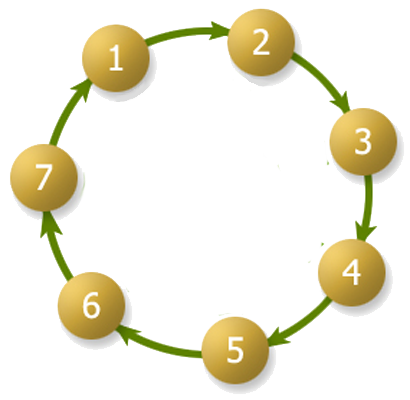

The main difference between a Webring and a Web Wheel
It would be interesting to know what effect, if any, webrings have on SEO but I haven't been able to find anything definitive. Webrings have never worked as even the early link wheels. The sites in webrings can vary wildly in content, style and quality but I really have no idea how search engines treat the links; good, bad or indifferently. One discussion from 2011, offers two point of views. One that that webrings were a type of SEO back in the day and another that search engines didn't even crawl the links.
Charles Moffat in his June 2011 article "The Value of WebRing: An Untapped Goldmine for SEO Entrepreneurs" argued that a good quality webring link would actually increase your pagerank in the search engines.
Nostalgia
Although some are still around, web rings had their heyday between 1996 and 2004 but in 2019/20 several retrospectives about web rings appeared such as "By Our Powers Combined" by Ernie Smith on Tedium, "How GeoCities webrings made the ‘90s internet a cozier place" by Brittany Vincent, and "Let's bring Fan Sites and webrings back!" by Bryan Robinson who even wrote a new web ring code. Another providing code was Chris Coyier who wrote "How You Might Build a Modern Day Webring" on CSS Tricks.
Will they ever make a comeback? I don't think so, but they were perfect for their time.
A Revival?
I completely rewrote this page in July 2021, a couple of months later in October, Ash posted to my Guestbook that perhaps I was wrong and that webrings are making a comeback mostly due to the interest in creating personal websites created by Neocities.
In January 2023, I created a list of all the webrings I could find.
The list of all the webrings this site belongs to can be found here.